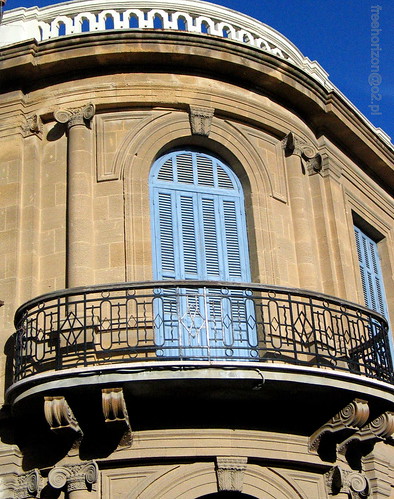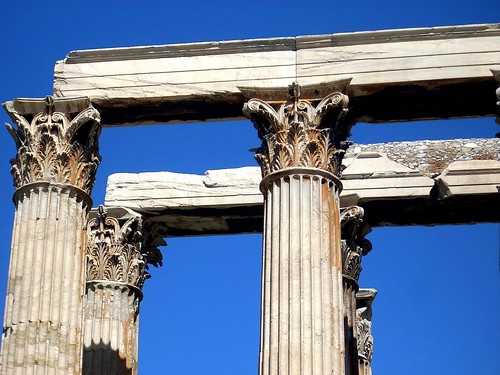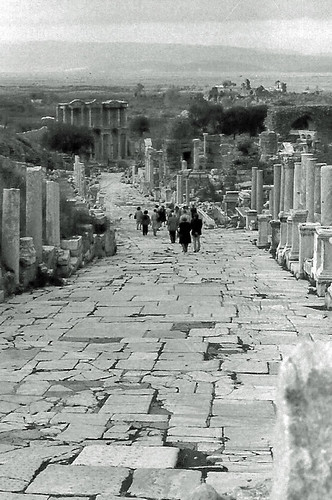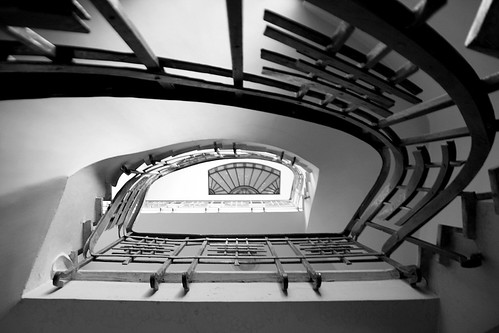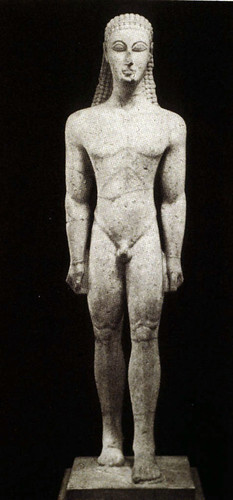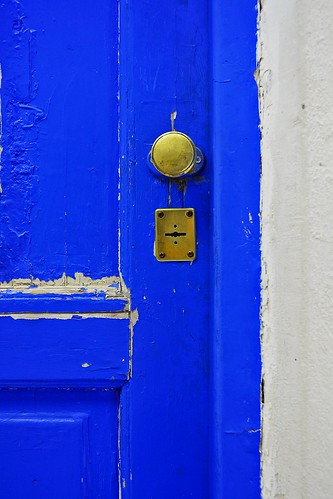
Louisville's vibrant and diverse arts community includes lively and active theatrical activities provided by the talented effort of Actors Theatre of Louisville, a Tony-Award-winning repertory theatre housed in a 1837 bank building now designated as a national historic landmark.and whose stone columned portion is one of the oldest buildings in Main Street and one of the finest examples of small scale Greek revival architecture in the U.S. As the centerpiece of the city's urban cultural district, Actors Theatre has made significant economic impact on a vital downtown life and won high acclaim for its artistic programming and business acumen in sponsoring the annual Humana festival of plays which have gone on to New York and London and other ingenious stage productions. The Broadway Series hosts touring productions of Broadway's best. It also presents approximately six hundred performances of about thirty productions during its year-round season, composed of a diverse array of contemporary and classical fare attracting one of the largest per capita subscription audiences in the country with an annual attendance of over 200,000.
Shakespeare's plays are continually being staged at the Central Park at South Fourth Street thus transforming Louisville into the Bardstown in summer. But sadly we missed Shakespeare when we trouped down there from our Kurtz Hall residence just up the road one evening and waited in vain for him and the players. We were to see either As You Like it or Romeo and Juliet.
Walden Theatre, the leading theatre conservatory for young people in the U.S, one of the few annual theatre festivals celebrating William Shakespeare in the annual Young American Shakespeare Festival, which are often presented at the Kentucky Center the three stages of which are always alive with entertainment from Broadway to Bach and featuring bagpipes to bluegrass. Five major arts groups delight the senses with music, dance theater, drama and more while its mirrored exterior reflecting the surrounding city. Opened in 1983 the center has multiple performance venues for the internationally renowned Louisville orchestra famous for its recordings of contemporary works, the Louisville ballet and Kentucky Opera which is the twelfth oldest opera in the U.S., the Broadway Series, Stage One, The Louisville Children's Theatre and extraordinary local, national, and international talents.
Images Friedonas Gallery features Julius Friedman's posters as well as works by many other nationally and internationally respected artists. This 10,000 square feet gallery in the Louisville Design Center, located in the downtown hotel and entertainment district, features a variety of plays and concerts.
The Louisville Palace, the official venue for the Louisville Orchestra, is an elegant, ornate theatre in downtown Louisville's so-called theatre district. In addition to orchestra performances, the theatre also features an array of popular movies, old and new, as well as concerts by popular artists. Located nearby is the Kentucky Theater, which was built in 1921 and operated for 60 years as a movie house, but was closed and almost demolished in 1986. Ultimately it was saved by local arts advocates, and the newly renovated Kentucky Theater opened its doors in 2000 and has become a vibrant community arts center and art film house.
The Kentucky Art and Craft Foundation Gallery serves as a spectacular retail outlet for some of Kentucky's finest craftworks and sponsors regular traveling exhibits and workshops.
The Fund for the Arts the first and oldest in the U.S. has the bust of its founder former Mayor Charles Farmsley sitting proudly as if still alive in front of its headquarters.
Louisville is distinguished, like many American cities, with a multitude of museums of art, science and sports as well as monuments and historic sites and homes preserved for posterity amongst which is The Speed Art Museum which I happened to have visited in June 2006. Though described as the state's first art museum holding collections spanning 6000 years with works by Rembrandt, Picasso, Monet, Rubens and Moore, modern American, African, ancient and Native American artists being exhibited here our visit was focused on the highly eclectic and post-modernist work of the African-American alumni of University of Louisville, Sam Gilliam whose works have traveled far and wide in America up to the Corcoran Gallery. His works are an adventurous and experimental combination of techniques and materials: pastiche, cloth-dyeing, candle work, wood, formica, mat-marking and pottery used to amazing effects especially in his daring display and combination of colors and use of space and the suggestion of patterned folds and ties hanging loose from the ceiling. An art learning center, a café Bristol and a Museum Shop exhibiting and hawking artifacts, curios and dresses from all over the world adds to Speed Arts Museum's compulsion.
The Speed Art Museum was founded in 1925 by Hattie Bishop Speed as a memorial to her husband, James Breckinridge Speed, a prominent Louisville businessman and philanthropist. Designed by Louisville architect Arthur Loomis, the museum opened its doors on January 15, 1927, with an exhibition sponsored by the Louisville Art Association.
In 1934, the museum received Its first major donation, a valuable collection of North American Indian artifacts given by Dr. Frederick Weygold in 1934 was followed in 1941 by, Dr. Preston Pope Satterwhite making a significant gift - his collection of 15th century and 16th century French and Italian Decorative Arts including tapestries and furniture.and in 1944, he donated the English renaissance room, which was moved in its entirety from Devonshire, England necessitating an enlargement of the museum. The addition bearing his name was completed in 1954, as the first of three additions to the original building.
The Speed Art Museum Kentucky's oldest and largest art museum with over 12,000 pieces in its permanent collection boasts of an extensive and historic collection ranging from ancient Egyptian to contemporary art featuring distinguished collections of 17th century Dutch and Flemish painting, 18th century French art, Renaissance and Baroque tapestries, and significant holdings of contemporary American painting and sculpture. African and Native American works are a growing segment of the museum's collection. On its upper level, small cabinet galleries provide an intimate atmosphere for the museum's collection of European paintings and sculpture.
During the tenure of Paul S. Harris the first professional director from 1946, acquisitions to the collection were made mostly in the areas of decorative arts and furniture. In 1962, he was succeeded by Addison Franklin Page, curator of contemporary art at the Detroit Institute of Arts. who further enriched and expanded the museum collection. After another major addition to the building in 1973, the Speed celebrated its 50th anniversary in 1977 with the acquisition of Rembrandt's magnificent Portrait of a Woman. Mr. Page and the Board of Governors led the campaign to raise the $1.5 million necessary to purchase the work, one of the museum's most significant acquisitions.
Mr. Page retired as Director in 1984 and was followed in 1986 by Peter Morrin, who was formerly curator of 20th century art at the High Museum in Atlanta who in continuing the enrichment of the collection, initiated an outreach program to involve the communities the museum serves. While the museum was closed for a dramatic renovation project in 1996, the museum received a life-changing gift, a bequest of more than $50 million from Alice Speed Stoll, granddaughter of James Breckinridge Speed. The bequest one of the largest given to any art museum significantly increased the Speed's endowment, ranking it among the top 25 in the United States. Mrs. Stoll's bequest secured the museum's future and has allowed for several significant acquisitions including Jacob van Ruisdael'si, (1653), and Paul Cezanne's Post-Impressionist masterpiece, Two Apples on a Table (about 1895-1900).
Since reopening in November 1997, the Speed Museum has dazzled the region with exciting traveling exhibitions,and new acquisitions to the permanent collection. It has also benefited greatly by a bequest from the estate of long-time Board of Governors member General Dillman A. Rash who left the museum works by Marc Chagall, Jean Dubuffet, Paul Klee, Henri Matisse, Pablo Picasso, and Maurice Utrillo.
The museum supported entirely by donations, endowments, grants, ticket sales, and memberships focuses its collection on Western art, from antiquity to the present day. Holdings of paintings from the Netherlands, French and Italian works, and contemporary art are particularly strong, with Sculpture prominent throughout. Representative artists include Rembrandt van Rijn, Peter Paul Rubens, Giovanni Tiepolo, Henry Moore, Thomas Gainsborough, Claude Monet, Pablo Picasso, and contemporary artists Frank Stella, Helen Frankenthaler, Sam Francis, Petah Coyne, Sam Gilliam, Vito Acconci, and Juan Munoz.
The Speed Art museum has come a long way since Mrs. Speed first opened the doors to the original museum nearly 80 years ago with its magnificent building and impressive collection of over 13,000 pieces serving more than 180,000 visitors each year, making it a nationally recognized institution.
The Speed Art Museum's original 1927 limestone building was designed by Louisville architect Arthur Loomis. Loomis chose the Greek Revival style for the exterior and employed large skylights in the roof to bathe the galleries in natural light. There have been three major additions and one extensive renovation to the original 1927 building.
The Preston Pope Satterwhite Wing was added in 1954 to honor Dr. Satterwhite, a prominent benefactor of the museum. The Satterwhite Wing contains much of his own collection of medieval and renaissance works including tapestries and other decorative arts. A focal point in the wing is a 17th century carved period room from England.
The North addition, designed by Brenner, Danforth, and Rockwell of Chicago, opened in 1973. This addition showcases the museum's 20th century art and features an auditorium and café.
The South addition, the museum's most recent wing, designed by Robert Geddes of Princeton, New Jersey, opened in 1983. On its upper level, small cabinet galleries provide an intimate atmosphere for the museum's collection of European paintings and sculpture. Also included in the addition are special galleries for temporary exhibitions.
Today, the Speed Art Museum has over 150,000 square feet of gallery, exhibition, and administrative space, making it the largest collection of art paintings, sculpture, furniture, and decorative arts by Kentucky artists. Since completing a major $12 million renovation and expansion in 1997, the Speed has brought major exhibitions of photography, painting, design, and sculpture to the region to help fulfill its ambitious mission: bringing great art and people together
The Speed Art Museum is housed in the University campus whilst the Kentucky Museum of Art and Craft, is located in Louville's "Museum Row" in the West Main District of downtown. It is a nonprofit organization founded in 1981 to continue the art and craft heritage of Kentucky through the support and education of craft artists and education of the public. It supports regional as well; as national artists thus illustrating Kentucky's long heritage of fine functional and decorative wood-working. The museum is supported in part by the Fund for the Arts and Kentucky Arts Council, a state agency of the Commerce Cabinet. Founded in 1981 by Phyllis George Brown, then First Lady of Kentucky and former Miss America, the Kentucky Museum of Art and Craft (formerly Art and Craft Foundation) was started as a dream to build interest in Kentucky's rich craft and art resources. With the help of Mary Shands, the seeds were quickly sown for the Kentucky Art and Craft Foundation to continue to develop and eventually have a physical presence in Louisville. In 1984 the organization moved into the lower level of 609 West Main Street for retail and exhibition space and in spite of West Main Street being very deserted, the importance and popularity of the organization exploded.
The Kentucky Museum of Art and Craft was established to promote the rich art and craft heritage of Kentucky through three main areas of programming: exhibition, education, and support of artists through a retail Gallery Shop. Since 1984 the organization has presented over 175 exhibitions, reaching approximately 65,000 viewers annually thus becoming a leader on the national forefront in preserving and advancing the art and craft heritage of Kentucky. by 1991. As part of the national "Year of the American Craft" the organization was recognized for its exemplary and unprecedented contributions to the documentation and interpretation of the cultural history of the commonwealth.
The organization has seen artists progress from novices to masters and Main Street transform from an almost a deserted noncommercial street to a thriving business and cultural district. By bringing the work of nationally recognized artists to Kentucky and by bringing the work of Kentucky artists to the national scene, KMAC has been able to preserve art and craft heritage and advance it.
Over ten years ago the organization started educational programming as part of their mission. In January of 2001 the organization purchased two adjacent buildings at 715 and 717 West Main Street in the heart of Louisville's West Main Street Historic District. Built in the 1880s the building is a four-story cast iron structure with a beautiful pastel facade and giant windows. After renovation, the facility provides the organization with 28,500 square feet of interior space in which to operate, spread over four floors and a lower level.The new facility increased the size and visibility of the Gallery Shop, with frontage on Main Street, and houses three exhibition galleries: the Steve Wilson Gallery, the Mary & Al Shands Gallery, and the Lindy & Bill Street Gallery. The Lindy & Bill Street Gallery, on the second floor overlooking Main Street, is rented for meetings and entertaining. The third floor houses the Education Center and the fourth floor is used for administrative offices.
Just across the street we saw the Frazier International History Museum holding as ever a collection of arms, armor and related historical artifacts dating from 1,000 years back.
West Main Street at the center of Old Louisville downtown is at the heart of the cultural district featuring the second largest collection of cast-iron facades in the U.S, which in itself is a collection of the rarest arts in the world as well as a reservoir of individual art pieces as well as artistic activities..
Iroquois Park is the home of the renovated Iroquois Amphitheater which hosts the productions of Music Theatre Louisville as well as a variety of musical concerts in a partially covered outdoor setting.
Louisville is home to a thriving music scene with bands such as the widely known Flaw, Musica Silentis Doloris (MSD), False, Incursion 502 and Evil Engine 9. It is also home to the former members of the once post-grunge band Days of the New.
On Fourth Street in downtown is the brand new Fourth Street Live! outdoor entertainment complex, which features a wide variety of restaurants, stores and nightclubs. The complex sponsors many free concerts, as does the popular Waterfront Park.
The large performing arts community played a role in the relocation of ZFX Inc, the second largest theatrical flying special effects company in the world, from Las Vegas to Louisville in 2006.
FURTHER READING ON ART IN LOUISVILLE:
http://www.art-sanctuary.org/about.php
Arthur Smith was born, grew up and was schooled in Freetown, Sierra Leone. He has taught English since 1977 at Prince of Wales School and, Milton Margai College of Education. He is now a Senior Lecturer at Fourah Bay College where he has been lecturing English, Literature, as well as Creative Writing for the past seven years.
Mr Smith is widely published with his writings appearing in local newspapers as well as in West Africa Magazine, Index on Censorship, Focus on Library and Information Work amongst others.
He was one of 17 international visitors who participated in a seminar on contemporary American Literature sponsored by the U.S.State Department in 2006. His growing thoughts and reflections on this trip which took him to various US sights and sounds could be read at http://www.lisnews.org
His other publications include: Folktales from Freetown, Langston Hughes: Life and Works Celebrating Black Dignity, and 'The Struggle of the Book'
